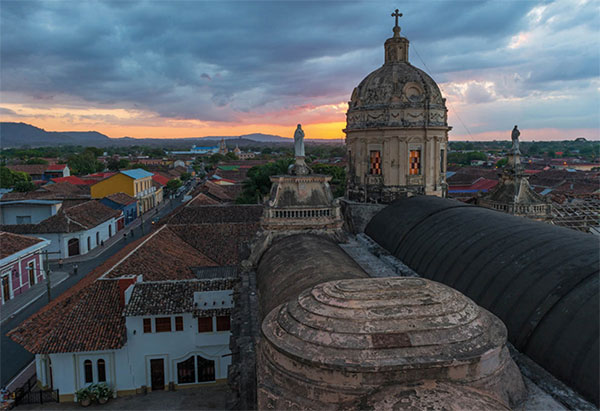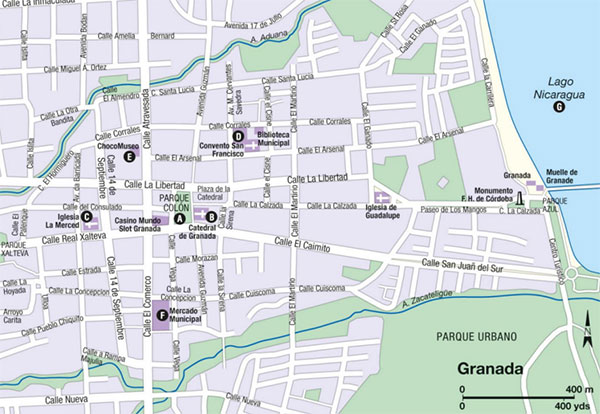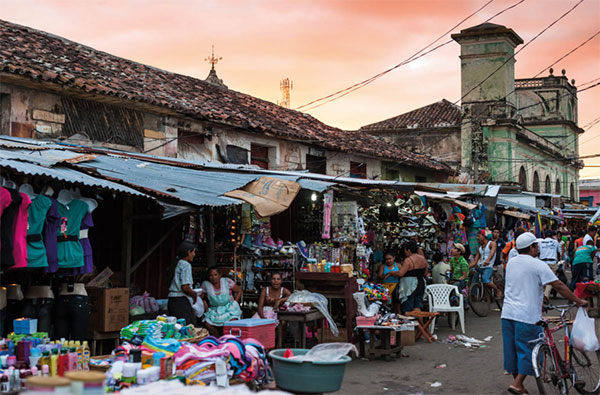Granada and the Masaya Region
The short distance between Managua and Lake Nicaragua is one of the most visited in Nicaragua. For many travelers, the cobblestone streets and colonial townhouses-turned-boutique hotels in Granada serve as a base from which they explore the rest of the country. Easy day trips from the city allow for hikes on the forested slopes of the Mombacho Volcano or for soaks in the hot springs below it. Options for extended stays in the wilderness can be found in the ecolodges along the turquoise waters of the Laguna de Apoyo or on the islands in the tranquil Isletas de Granada on the lake.
Granada and around
Founded in 1524 by Francisco Hernández de Córdoba, Granada 8 [map] , near the base of the Mombacho Volcano, was the first official European city in mainland America. La Gran Sultana, nicknamed for its Moorish and Andalusian architecture, was an important port city on Lake Nicaragua throughout the colonial period, making it a target for English, French and Dutch pirate attacks. In 1856 American adventurer William Walker, after taking up residence in the city, set it on fire while surrounded by opposing forces, planting a sign declaring ‘Here was Granada.’ Despite the tumultuous history, Granada has some of the best preserved colonial architecture in all of Central America.
Orientation
The center of Granada’s historic core is at Parque Colón A [map] , a vibrant central square where parrots squawk in the tall palms and food stands sell vigorón, a traditional snack of pork and cabbage wrapped in banana leaf. Surrounding the plaza are many colonial buildings, like the ritzy Hotel Plaza Colón (http://hotelplazacolon.com) and the Catedral de Granada B [map] (hours vary; free), which was originally built in 1583, though it has been destroyed and rebuilt multiple times. Also on the plaza is the Casa de los Leones, an elegant house that dates to 1720, now a cultural center.

The skyline of Granada at sunset.
iStock
At Real Xalteva and 14 de Septiembre, the Baroque Iglesia La Merced C [map] (daily 11am–6pm) dates to 1534 and has undergone several rebuilds and renovations, although it has maintained its beauty. Inside, a spiral staircase leads up to a bell tower with some of the best views of the city. The pale blue Convento San Francisco D [map] (Mon–Fri 8am–5pm, Sat–Sun 8am–4pm), one of Nicaragua’s oldest buildings, is a block farther east of the cathedral. Having been famously destroyed by both the pirate Henry Morgan in 1679 and then by William Walker in 1856, the galleries now contain a museum (daily) with a collection of pre-Columbian basalt statues from Zapatera Island.
On Calle Atravesada northwest of the plaza is the Choco Museo E [map] (www.chocomuseo.com; daily 10am–6pm), a chocolate store with chocolate-making workshops, a small museum and farm tours. East of the plaza, along the pedestrian-only Calle La Calzada, is the primary concentration of stores, restaurants, and nightspots in the city. Several hip boutique hotels like the Hotel Dario (www.hoteldario.com) and Tribal (www.tribal-hotel.com) are found here as well. To the south is the neoclassical Mercado Municipal F [map] , constructed in 1892, which spills out into the surrounding streets, while farther west is the municipal cemetery, with stone tombs that date to the late 19th-century and contain the remains of six Nicaraguan presidents. There’s also the neoclassical Capilla de Animas, modeled after a French chapel.
On the eastern end of Calle La Calzada is the shore of Lake Nicaragua G [map] where there are a few bars and a waterfront boardwalk that gets crowded on weekends.
Outside of Granada
Twenty-minutes west of Granada is the Laguna de Apoyo 9 [map] , Nicaragua’s largest volcanic lagoon. More than 200 meters (656 ft) deep and 6km (4 miles) in diameter, the caldera is ringed with lush forests where toucans and white-face monkeys can easily be spotted on a short hike. A few restaurants and ecolodges, some of which rent kayaks, can be found on a strip along the northwestern shore of Apoyo, though the majority of visitors come on a day trip from Granada.

The archipelago of 354 jungle clad islands called Las Isletas ) [map] are easily reached from Granada’s waterfront. While many of the islands have been purchased by wealthy residents of Managua, who have built mansions on them, others – often just the length of a fishing line away – are quite humble, with rustic yet charming wooden shacks. From the southern end of the Complejo Turístico Cocibolca near Granada, boat tours explore the islands, stopping at the small Spanish fort of San Pablo. Another way of experiencing Las Isletas is to stay at the eco-friendly Jicaro Island Lodge (www.jicaroisland.com), the premier hotel in Las Isletas and built using local materials. The lodge helps fund an organic farm on one of the islands and supports several schools.
Managed by the Fundación Cocibolca – which has built a network of trails, a butterfly garden and organic coffee farm – the Mombacho Volcano Natural Reserve south of Granada along the lake is a popular day trip from Granada. Home to three species of monkeys and nearly two hundred species of birds, the lush jungle here has been well preserved. Treks go up to the lip of the crater and around, though the steep, sweaty trails are not for the unfit.
Masaya
Nicaragua’s capital of folklore, Masaya ! [map] , is just 9km (5.5 miles) from Granada. Surrounded by hissing volcanoes and tiny rural villages known for their handicrafts, Masaya is where to come to buy souvenirs. While the city of 100,000 was badly damaged in the 2000 earthquake, the markets, craft workshops, and old churches here remain in good condition. Most head straight for the Mercado de Artesanías de Masaya, an artisan market selling hammocks, pottery, woodcarvings, and leather goods, among other things.

Market day in Granada.
iStock
It’s also possible to go direct to the source of the handicrafts, which are mostly created in a string of mountain villages called the Pueblos Blancos. Scattered within 15 km (9 miles) of the city are Nindiri, Niquinohomo, Masatepe, Catarina, Diria, and Diriomo, each with their own specialty.